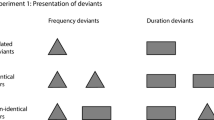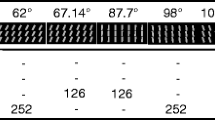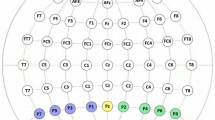Abstract
The mismatch negativity (MMN) is an event related potential component elicited by changes in duration, frequency or intensity of the stimuli during repetitive series of equal standard stimuli. In the present study we compared duration and frequency MMN using dipole source analysis concerning both the test-retest reliability of MMN-amplitudes and the locations of the potential sources. Furthermore, the influence of attention for test-retest-reliability was studied. Therefore, two groups of healthy subjects were investigated with different attentional manipulations. Twenty-one healthy subjects had to perform a visual attention task during the recording and 21 healthy subjects had no additional task to perform. All subjects were studied twice with a time interval of 3 weeks. Test-retest reliability was sufficiently high for the frequency but slightly lower for the duration MMN. The locations of the frequency and duration MMN-dipoles were in the auditory cortex with a more anterior and caudal location for the frequency MMN-dipoles. The latter finding supports the hypothesis that the frequency and duration MMNs have separate neuronal generators.
Similar content being viewed by others
References
Alho, K. Selective attention in auditory processing as revealed by enent-related brain potentials. Psychophysiology, 1992, 29: 247–263.
Alho, k., Huotilainen, M. and Näätänen, R. Are memory traces for simple and comlex sounds located in diffeent regions of auditory cortex ? Recent MEG studies. Electroenceph. clin. Neurophysiol., 1995, 44:Suppl., 197–203.
Asnuma, A., Wong, D. and Suga, N. Frequency and amplitude representations in anterior primary auditory cortex of the mustached bat. J. Neurophysiol., 1983, 50: 1182–1196.
Catts, S.V., Shelley, A.M., Ward, P.B., Liebert, B., McConaghy, N., Andrews, S., Michie, P.T. Brain potential evidence for an auditory sensory memory deficit in schizophrenia. Am J Psychiatry, 1995, 152: 213–219.
Csépe, V., karmos, G. and Molnar, M. Evoked potential correlates of stimulus deviance wakefulness and sleep in cat: Animal model of mismatch negativity. Electroenceph. Clin. Neurophysiol., 1987, 66: 571–578.
Csépe, V., Pantev, C, Hoke, M., Hampson, S. and Ross, B. Evoked magnetc responses to minor pitch changes: localization of the mismatch field. Electroenceph. Clin. Neurophysiol., 1992, 84: 538–548.
Fisher, R.A. Statistical methods for research workers. New York, Hafner, 1958.
Giard, M. H., Perrin, P. and Pernier, J. Brain generators implicated in processing of auditory stimulus deviance: a topographic ERP study. Psychophysiology, 1990, 27: 627–640.
Giard, M. H., Perrin, F. and Pernier, J. Scalp topographies dissociate attentional ERP components during the auditory information processing. Acta Oto-Laryngol., 1991, 491Suppl.: 168–175.
Giard, M. H., Lavikainen, J., Reinikainen, K., Perrin, E., Bertrand, O., Pernier, J., Näätänen, R. Separate Representation of Stimulus Frequency, Intensity, and Duration in auditory sensory memory: an event-related potential and dipole-model analysis. J. Cognitive Neurosc., 1995, 7: 133–143.
Hari, R., Hämäläinen, M., Ilmoniemi, R., Kaukoranta, E., Reinikainen, K., Salminen, J., Alho, K., Näätänen, R. and Sams, M. Responses of the primary auditory cortex to pitch changes in a sequence of tone pips: Neuromagnetic recordings in man. Neurosci. Lett., 1984, 50: 127–132.
Hegerl, U., Galinat, J., Mrowinski, D. Intensity dependence of auditory evoked dipole source activity. Int. J. Psychophysiol., 1994, 17: 1–13.
Hegerl, U. and Frodl-Bauch, T. Dipole source analysis of the auditory evoked P300: a methodological advance. Psych. Res. Neuroim., 1977, 74: in press.
Javitt, D.C., Schroeder, C. E., Arezzo, J. C. and Vaughan Jr., H. C. Selective inhibition of processing-contingent auditory event-related potentials by phencyclidine (PCP)-like agent MK-801. Electroenceph. Clin. Neurphysiol., 1991, 75: 65P.
Javitt, D. C., Schroeder, C. E., Steinschneider; M, Arezzo, J. C., Ritter, W. and Vaughan Jr, H.G. Cognitive enent-related potentials in human and non-human proimates: implications for the PCP/NMDAo model of schizophrenia. Electroenceph. Clin. Neurophysiol., 1995, 44Suppl.: 161–175.
Kathmann, N., Wagner, M., Rendtorff, N., Engel, R. R. Delayed peak latency of the mismatch negativity in schizophrenics and alcoholics. Biol. Psychiat., 1995, 37: 754–757.
Merzenich, M. M. and Brugge, J. F. Representation of the cochlear partition on the superior temporal plane of the macaque monkey. Brain Res., 1973, 50: 275–296.
Näätänen, R., Gaillard, A.W.K. and Mantysalo, S. Early selective-attention effect on evoked potential reinterpreted. Acta SPsychol., 1978, 42: 313–329.
Näätänen, R., Gaillard, A.W.K., and Mantysalo, S. Brain potential correlates of voluntary and involuntary attention. In: H.H. Kornhuber and L. Deecke (Eds.), Motor and Sensory Processes of the Brain: Electrical Potentials, Behavior and Clinical Use, 54. Elsevier, Amsterdam, 1980: 343–348.
Näätänen, R. Mismatch negativity outside strong attentional focus: a commentary on Woldorff et al. (1991). Psychophysiology, 1991, 28: 30–42.
Näätänen, R. Attention and brain function. tiHillsdale, NJ: Erlbaum, 1992.
Näätänen, R., Paavilainen, P., Tiitinen, D., Jiang, D and Alho, K. Attention and mismatch negativity. Psychophysiology, 1933, 30: 436–450.
Phillips, D.P. and Orman, S.S. Responses of single neurons in posterior field of cat auditory cortex to tonal stimulation. J.Neurophysiol., 1084, 51: 147–163.
Phillips, D. P. Orman, S. S., Musicant, A. D. and Wilson, G.F. Neurons in the cat's pimary auditory cortex distinguished by their responses to tones and wide-spectrum noise. Hearing Res., 1985, 18: 73–86.
Sams, M., Alho, K. and Näätänen, R. Short-trem habituation and dishabituation of the mismatch negativity of the ERP. Psychophysiology, 1984, 21: 434–441.
Sams, M., Paavilainen, P., Alho, K., and Näätänen, R. Auditory frequency discrimination and event-related potentials. Electroenceph. Clin. Neurophysiol., 1985, 62: 437–448.
Sams, M. Cortical responses to changes in auditory stimuli. Acta Oto-Laryngol., 1991, 491Suppl.: 124–130.
Shelley, A. M., Word, P. B., Catts, S. V., Michie, P. T., Andrews, S. and McConaghy, N. Mismatch negativity: an index of a preattentive processing deficity in schizophrenia. Biol. Psychiat., 1991, 30: 1059–1062.
Scherg, M. and von Cramon, D. Two bilateral sources of the late AEP as identified by spatio-temporal dipole model. Electroenceph. Clin. Neurphysiol., 1985, 62: 32–44.
Scherg, M. and von Cramon, D. Evoked dipole source potentials of the human auditory corex. Electroenceph. Clin. Neurophysiol., 1986, 65: 344–360.
Scherg, M., Vajsar, J. and Picton, T. W. A source analysis of the human auditory evoked potentials. J. Cogn. Neurosci., 1989, 1: 336–355.
Scherg, M., and von Cramon, D. Dipole source potentials of the auditory cortex in normal subjects and in patients with temporal lobe lesions. Adv. Audiol., 1990, 6: 165–193.
Scherg, M., and Picton, T. W. Separation and identification of event-related potential components by brain electrical source analysis. Electroenceph. Clin. Neurophysiol., 1991, 42Suppl.: 24–37.
Schreiner, C. E., Mendelson, J. R. and Sutter, M. L. Functional topography of cat primary auditory cortex: Representation of tone intensity. Exp. Brain Res., 92: 105–122.
Tiitinen, H., Alho, K., Huotiainen, M., Ilmoniemi, R. J., Simola, J. and Näätänen, R. Tonotopic auditory cortex and Magnetencephalographic (MEG) equievalent of the mismatch negativity. Psychophysiology, 1993, 30: 537–540.
Winer, B.J. Statistical principles in experimental design. New York, McGraw-Hill, 1962.
Woleorff, M.G., Hackley, S.A., Hillyard, S.A. The effects of channel-selective attention on the mismatch negativity wave elicited by deviant tones. Psychophysiology, 1991, 28: 30–42.
Author information
Authors and Affiliations
Rights and permissions
About this article
Cite this article
Frodl-Bauch, T., Kathmann, N., Möller, HJ. et al. Dipole Localization and Test-Retest Reliability of Frequency and Duration Mismatch Negativity Generator Processes. Brain Topogr 10, 3–8 (1997). https://doi.org/10.1023/A:1022214905452
Issue Date:
DOI: https://doi.org/10.1023/A:1022214905452




